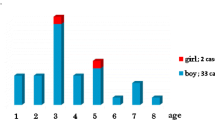Abstract
Sagittal suture synostosis is one of the most common craniosynostoses and is often diagnosed by characteristic narrow and long skull shape, scaphocephaly. However, some patients with sagittal suture synostosis do not present with typical scaphocephaly, making early diagnosis difficult. In this study, five cases of characteristic skull deformity showing a narrowing of the cranium posterior to the coronal suture on computed tomography (CT) are presented. The three older children presented with papilledema and intellectual disability and a closed sagittal suture on CT. The two infant cases were diagnosed with the characteristic cranial deformities with aggravation of the deformity over time, but sagittal suture closure was not evident on CT. All patients underwent cranial remodeling surgery. In the two infant cases, the histopathological findings showed that the anterior part of the sagittal suture was firmly fused with fibrous tissue without bony fusion. These findings suggested that narrowing of the cranium posterior to the coronal suture might be due to functional fusion of the anterior portion of the sagittal suture prior to bony fusion. In an infant presenting with such a deformity that shows aggravation of the deformity over time, surgical treatment should be considered.




Similar content being viewed by others
References
Rocco F, Gleizal A, Szathmari A et al (2019) Sagittal suture craniosynostosis or craniosynostoses? The heterogeneity of the most common premature fusion of the cranial sutures. Neurochirurgie 65(5):232–238
Vinchon M, Pellerin P, Guerreschi P et al (2012) Atypical scaphocephaly: a review. Childs Nerv Syst 28:1319–1325
Heuzė Y, Boyadjiev S, Marsh J et al (2010) New insights into the relationship between suture closure and craniofacial dysmorphology in sagittal nonsyndromic craniosynostosis. J Anat 217(2):85–96
Guevara C, Wallender A, Steinberg B et al (2016) Primary delayed onset craniosynostosis in a child demonstrated by serial computed tomography imaging. Int J Oral Maxillofac Surg 45:1347–1350
Rocco F, Rothenbuhler A, Daire V et al (2019) Craniosynostosis and metabolic bone disorder. A review Neurochirurgie 65(5):258–263
Twigg S, Wilkie A (2015) A genetic-pathophysiological framework for craniosynostosis. Am J Hum Genet 3;97(3):359–377
Katsianou M, Adamopoulos C, Vastardis H et al (2016) Signaling mechanisms implicated in cranial sutures pathophysiology: craniosynostosis. BBA Clin 29(6):165–176
Morriss-Kay G, Wilkie A (2005) Growth of the normal skull vault and its alteration in craniosynostosis: insights from human genetics and experimental studies. J Anat 207(5):637–653
Opperman L, Adab K, Gakunga P (2000) Transforming growth factor-beta 2 and TGF-beta 3 regulate fetal rat cranial suture morphogenesis by regulating rates of cell proliferation and apoptosis. Dev Dyn 219(2):237–247
Karabagli P (2013) Pathology in metopic synostosis. Childs Nerv Syst 29:2165–2170
Albright A, Byrd R (1981) Suture pathology in craniosynostosis. J Neurosurg 54(3):384–387
Opperman L (2000) Cranial sutures as intramembranous bone growth sites. Dev Dyn 219(4):472–485
Furuya Y, Edwards M, Alpers C et al (1984) Computerized tomography of cranial sutures. Part 1: comparison of suture anatomy in children and adults. J Neurosurg 61(1):53–58
Ozaki W, Buchman S, Muraszko K et al (1998) Investigation of the influences of biomechanical force on the ultrastructure of human sagittal craniosynostosis. Plast Reconstr Surg 102(5):1385–1394
Hinton D, Becker L, Muakkassa K et al (1984) Lambdoid synostosis. Part 1. The lambdoid suture: normal development and pathology of “synostosis”. J Neurosurg 61(2):333–339
Al-Rekabi Z, Cunningham M, Sniadecki N (2017) Cell mechanics of craniosynostosis. ACS Biomater Sci Eng 13;3(11):2733–2743
Ciurea A, Toader C (2009) Genetics of craniosynostosis: review of the literature. J Med Life 2(1):5–17
D’Antoni A, Donaldson O, Schmidt C et al (2017) A comprehensive review of the anterior fontanelle: embryology, anatomy, and clinical considerations. Childs Nerv Syst 33(6):909–914
Beederman M, Farina E, Reid R (2014) Molecular basis of cranial suture biology and disease: osteoblastic and osteoclastic perspectives. Genes Dis (1):120–125
Chong S, Wang K, Phi J et al (2016) Minimally invasive suturectomy and postoperative helmet therapy: advantages and limitations. J Korean Neurosurg Soc 59(3):227–232
Hwang J, Yang J, Kim K et al (2021) Combined unilateral coronal-lambdoid suture synostosis: surgical outcome of suturectomy and postoperative helmet therapy. Childs Nerv Syst 37(1):277–286
Rottgers S, Lohani S, Proctor M (2016) Outcomes of endoscopic suturectomy with postoperative helmet therapy in bilateral coronal craniosynostosis. J Neurosurg Pediatr 18(3):281–286
Lobb D, Patel S, Pan B et al (2021) Partial suturectomy for phenotypical craniosynostosis caused by incomplete fusion of cranial sutures: a novel surgical solution. Neurosurg Focus 50(4):E6
Muakkassa K, Hoffman H, Hinton D et al (1984)Lambdoid synostosis. Part 2: review of cases managed at The Hospital for Sick Children, 1972–1982. J Neurosurg 61:340–347
Rhodes J, Tye G, Fearon J et al (2014) Craniosynostosis of the lambdoid suture. Semin Plast Surg 28:138–143
Schweitzer T, Kunz F, Meyer-Marcotty P et al (2015) Diagnostic features of prematurely fused cranial sutures on plain skull X-rays. Childs Nerv Syst 31:2071–2080
Massimi L, Bianchi F, Frassanito P et al (2019) Imaging in craniosynostosis: when and what? Childs Nerv Syst 35(11):2055–2069
Author information
Authors and Affiliations
Contributions
Inukai Madoka and Hayashi Toshiaki wrote the main manuscript and text. Kimiwada Tomomi, Sanada Takehiko and Hayashi Toshiaki collected data. Shimanuki Yoshihisa and Kitami Masahiro performed radiological review. Takeyama Junji performed pathological review. Kumabe Toshihiro and Endo Hidenori supervised the study. All authors reviewed the manuscript.
Corresponding author
Ethics declarations
Conflict of interest
The authors declare that they have no conflicts of interest.
Additional information
Publisher's Note
Springer Nature remains neutral with regard to jurisdictional claims in published maps and institutional affiliations.
Rights and permissions
Springer Nature or its licensor (e.g. a society or other partner) holds exclusive rights to this article under a publishing agreement with the author(s) or other rightsholder(s); author self-archiving of the accepted manuscript version of this article is solely governed by the terms of such publishing agreement and applicable law.
About this article
Cite this article
Madoka, I., Toshiaki, H., Tomomi, K. et al. Atypical sagittal suture craniosynostosis: pathological considerations for early closure of the anterior part of the sagittal suture. Childs Nerv Syst 40, 575–580 (2024). https://doi.org/10.1007/s00381-023-06141-6
Received:
Accepted:
Published:
Issue Date:
DOI: https://doi.org/10.1007/s00381-023-06141-6




